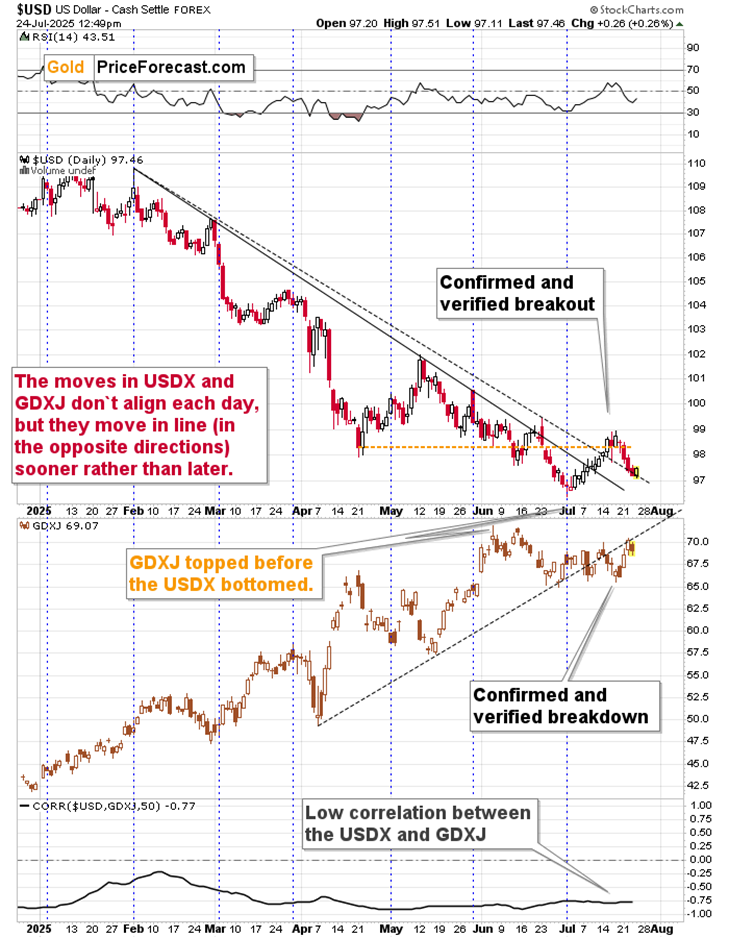In the current financial landscape, discussions around tariffs and their impact on the dollar (USD) have been swirling, creating a complex picture for investors and economists alike. To unpack this scenario, we need to delve into recent developments and historical context, understanding how tariff situations, particularly those instigated by the U.S., have influenced the USD’s performance against a basket of currencies.
Starting off, it’s crucial to establish that the USD Index has not invalidated its breakout above a key declining resistance line. This technical perspective underlines a bullish outlook for the dollar, suggesting that recent dips in its value are merely a hiatus in preparation for an upcoming rally. This resilience in the face of fluctuating tariff news is telling of the underlying strength of the USD.
Historically, the tariff dialogue has had significant bearings on currency valuations, especially in the realm shaped by the Trump administration. A key moment came around June 1, 2025, when President Trump threatened to impose crippling tariffs on imports from the European Union (EU). The prospect of such economic barriers sent ripples through financial markets, only for the tensions to be temporarily eased on May 25, 2025, following a conversation with EU Commission President Ursula von der Leyen, pushing the deadline to July 9, 2025. This act of last-minute diplomacy hinted at a pattern of flexibility that would come to be expected by markets – a crucial factor in financial forecasting.
The situation evolved further as we approached the July deadlines – crucial dates that included the expiration of a pause on reciprocal tariffs and the extended deadline for the EU. President Trump’s comments in late June hinted at further flexibility, which, in turn, influenced market expectations and the USD’s value. The market had learned from previous instances and anticipated another postponement, leading to a significant bottoming out of the USD Index on July 1, 2025, shortly after Trump’s remarks on deadline flexibility.
Jumping forward to the present, as we stand on the cusp of another deadline on August 1, it’s pertinent to note the established pattern and market expectations around tariff announcements and their timing. The recent strength observed in the USD Index, breaking above significant resistance levels, indicates a shift in the fundamental narrative. Unlike past scenarios where tariff uncertainties weakened the dollar, the current stance positions tariffs as a factor potentially bolstering the USD. This shift underscores a market now more attuned to the longer-term bullish implications of U.S. tariff policies on the dollar’s strength.
The recent confirmation of a trade deal with Japan and the looming possibility of the EU facing similar tariffs further cements a theory I term as “Peak Chaos.” This theory suggests a stage where fundamental and emotional market forces align, propelling the USD Index higher. This context is pivotal, considering President Trump’s propensity for securing deals that showcase the effectiveness of his confrontational approach.
This leads us to a critical juncture in our analysis. The current market consolidation doesn’t undermine the bullish pattern for the USD; rather, it aligns with historical templates where gradual recoveries followed significant bottoms. Therefore, we might anticipate a continued ascension of the USD in the days and weeks ahead.
Furthermore, this trend spells significant implications for assets inversely correlated with the USD, such as gold and other precious metals. Already, gold prices have shown a downturn, hinting at a broader confirmation of the bearish trend suggested by the breakdown below its rising support line.
Historical patterns in gold’s performance, particularly the reversal after touching its declining resistance line and the breakdown below the critical 78.6% Fibonacci retracement level, reaffirm the anticipations of a downturn. This resemblance to patterns seen in late 2012 further strengthens the bearish outlook for precious metals in the face of a strengthening dollar.
In essence, the intertwining of tariff policies, diplomatic negotiations, and market responses sketches a complex yet decipherable picture of the USD’s trajectory. The resolution of these tariff issues, paired with market sentiment and technical indicators, suggests a bullish outlook for the USD. For investors and market watchers, understanding these dynamics – rooted in recent historical contexts and influenced by geopolitical manoeuvres – is essential in navigating the choppy waters of global finance. As we move forward, the evolving tariff dialogue and its implications for the USD and correlated assets remain a critical storyline to follow.


